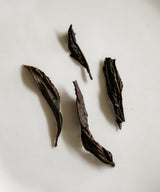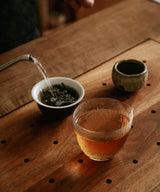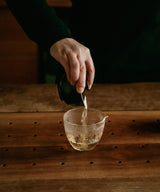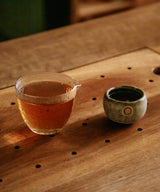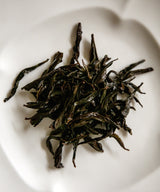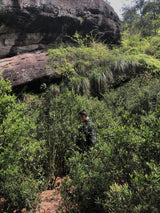Dahongpao Jade Lion Cliff 2014
青狮岩大红袍
Harvest
May 2014
Origin
Wuyishan, Fujian
This True Cliff yancha, a blend of three varietals: Rougui, Shuixian and Meizhan, we call “Dahongpao.” This is a name that can not be explained without a story.
In 1385, a scholar named Ding Xian was on his way to Beijing to participate in the annual Imperial Examination. As he passed Wuyi Mountain he fell ill with a stomach ache. He met a monk near Tianxin Temple in the Wuyi Mountains, who made him tea. After drinking the tea, Ding Xian was relieved of his illness and was able to carry on with his journey. He ended up achieving the highest score at the highest level of the Imperial Examination, and was awarded the prestigious title of Principle Graduate. Ding Xian returned to Wuyi Mountain to thank the monk, and asked what the tea was and where its trees were. He went to the tea trees and draped the big red robe he had been awarded as winner of the examination, that he was meant to wear at the imperial court to signify his high standing, on the tea trees. The monk placed some of the tea in a tin can and Ding Xian brought it back to Beijing with him.
Upon returning to the Imperial Palace in Peking, the Queen happened to fall ill and none of the medical treatments were treating her condition. Ding Xuan brought out some of the tea he had carried from the Wuyi Mountain and offered it to the queen. She drank it, and quickly regained her health. The Emperor was extremely relieved and gave Ding Xuan another big red robe, a significant gift, as no one was allowed to wear the color red except for the Emperor and his family, unless the red garment had been given to them by the Emperor himself. The Emperor sent Ding Xuan back to Wuyi Mountain to put another red robe on the tea trees and he arranged that someone would always look after these tea trees, and take care of them. The tea leaves harvested from these tea trees were deemed to be Tribute Teas, only for the Emperor and his family. Since then, the renowned tea from these trees on Wuyi Mountain have been called Dahongpao (“Big Red Robe”).
Nowadays, Dahongpao is used synonymously with Wuyi Rock oolong. Almost all of the time, when people mention Dahongpao, it is meant as Wuyi Rock Oolong. Strictly speaking, however, only the six mother trees that Ding Xuan had visited in 1385 and still remain, protected and looked after to this day, can be called Dahongpao varietal. These mother trees are no longer harvested, and haven’t been for a long time. No one in the Wuyi Mountains has tasted the tea of Dahongpao, and yet what it is thought to taste like remains the ideal profile for all Wuyi Rock Oolongs.
This “Dahongpao” is an experimental tea, crafted to reference what the tea of Big Red Robe might taste like. It comes by its name honestly, as the artisan who crafts this tea is named Dahongpao as a tribute to the original Wuyi Rock tea. This tea is modeled after what they imagine Dahongpao would have tasted like almost a thousand years ago. It is a blend of three varietals: Rougui, Shuixian and Meizhan. It is True Cliff, from Qingshiyan, or “Jade Lion Cliff,” inside the boundaries of Wuyi Nature Reserve.
Qingshiyan (Jade Lion Cliff) is situated close to Shuiliandong (Water Curtain Cave). Its name reflects the shape of the Cliff: the abrupt and towering cliff looks like a crouching lion. The tea trees of Qingshiyan are shaded by bamboo trees and surrounded by a high diversity of flora and fauna. A stream flows continuously at Qingshiyan, throughout every season. The water accumulates at the bottom of the cliff, forming a small pool that is always present, whether it is winter or summer.
Made with reference to a now mythological flavour, the craftsmanship of this tea acknowledges a generational understanding of what constitutes an excellent True Cliff Oolong. The quality of the three teas used in this tribute to an ancient Tribute Tea, and towards this experiment in cultural memory, makes this “Dahongpao” captivating for many reasons.
It is explosive on the palate, as the complexity of all three interrelating varietals comes forth at once. The impact and its pronounced mineral wakes up the senses; it does something like sake kasu or intense umami – it makes it so that we taste more. This opening, or broadening, is true for the energy of the tea as well: it is an extroverting tea, and one that broadens our awareness of what surrounds us. There is imagination in this Rock Oolong, however etched in stone it might be.
. . .
Brewing guide
The key to brewing this tea is to use boiling water, and quick infusions, starting at 10 seconds.
| Tea | 5 g |
| Temperature |
100°C |
| Water | 120 ml |
| Steep time | 10 - 60 sec |
| No. of infusions | 10 |

